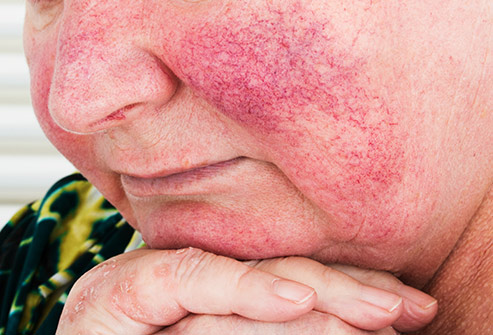You don’t have to be a beauty-obsessed person to want clear skin on your face. One of the most annoying conditions to affect the appearance of your face is rosacea. Many rosacea sufferers wonder about red light therapy for rosacea. Indeed, almost everyone who suffers from this skin condition wants a safe remedy. Accordingly, red light therapy may be a great option.

What is Rosacea?
The Mayo Clinic defines rosacea as an inflammation in facial skin. As a result, the face looks red and puffy. An affected person may have pus-filled bumps on their face. Awkward-looking blood vessels can appear just under the surface of the skin.
This annoying condition can affect anyone. But it most commonly affects fair-skinned, middle-aged women. It also affects smokers. In severe cases, it can lead to eye problems and an enlarged nose.
A number of factors can cause a rosacea outbreak, including foods and beverages (such as spicy foods and alcohol). Also, exposure to certain weather conditions like very hot or very cold temperatures, sunlight, or wind can trigger an outbreak. Sometimes even exercise, blood pressure medications, cosmetic products, and emotional changes cause a rosacea outbreak.
Can Red Light Therapy Reduce or Eliminate Rosacea?
Skin disorders have been studied by researchers for many years. Accordingly, many therapies have been evaluated as potential treatments. These include topical lotions, medications, and even photonics (light).
So why how does light therapy work? Well, “photoreceptors” are the molecules that receive light in skin tissue. These photoreceptors within skin cells absorb light. This, in turn, stimulates the production of ATP. ATP is the chemical that triggers repair activity within the cells. The energy released by ATP helps healthy cells reproduce while signaling to others that they should repair.
One clinical trial conducted by Massachusetts General Hospital involved treating acne sufferers with 635nm light. (Acne is a similar skin condition that affects the face.) People in the study ranged from 14 years of age up to 50 years of age.
In a separate study, people were treated with 590nm LEDs on half of their faces following laser skin resurfacing. The purpose of the study was to see if red light therapy reduces erythema, or redness in the face. Both conditions cause extensive reddening of facial skin.
Red Light Reduces Inflammation
Inflammation is generally the root cause of rosacea. Therefore, red light therapy delivers results through its ability to reduce inflammation.
Light has the ability to penetrate the skin and into the body. The depth of light penetration depends on its wavelength. Accordingly, red light can penetrate about 3/8 of an inch. In order to fully penetrate skin, 600nm to 700nm wavelengths of light are needed.
When enough photoreceptors absorb enough light, molecular events begin to occur. One type of molecular event is the production of ATP, or the energy-transmitting chemical within the cell.
ATP production starts the cellular processes that reduce rosacea symptoms.
The redness and sensitivity of your skin is because of inflamed tissue. As a result of exposure to red light, sufferers feel relief. Sensations like burning or itching subside.
Healing Cells Reproduce Faster
650nm red light also helps healing cells reproduce faster. Bumps, puffiness, and pus won’t go away unless healing cells are plentiful in the damaged area.
Cell Migration Increases
Damaged skin tissue needs to be repaired. And healthy cells need to reproduce. The presence of healthy cells repairs damaged areas more quickly. Red light can help increase the number of healthy cells in the area by moving them from other parts of the body.
There are many types of cells involved in healing tissue. For instance, two types of cells in the body that repair wounds are the HGF-1 and L929 cells. When cells travel to these areas, healing accelerates. Red light is clinically proven to stimulate this process.
Collagen Production is Stimulated
Collagen gives structure to your skin. It is an important protein that results in skin density. Think of it as a sticky, glue-like fiber that holds together tissue.
Red light therapy increases collagen density, according to a 2012 study conducted in Germany. So people who suffer from rosacea, acne, and other skin inflammation conditions might find that their skin looks AND feels better.
Benefits of Red Light Therapy for Rosacea
If you’ve read our beginner’s guide, then you know that we’re advocates of red light therapy for rosacea and a host of other skin conditions. If you’re considering using low level light as part of a healthier skin program, there’s not much downside other than time and cost.
But there’s a whole lot of upside.
- Rapid relief from burning/itching. Results can be felt in minutes.
- Potential to reduce the severity of future outbreaks. By keeping skin tissue healthy, it is less likely to overreact to future stimulants.
- Look and tone of skin improves. When you reduce inflammation, redness goes away and natural color returns to the face.
- Smoother feeling skin. Bumps and swollen skin give way to smoother, silkier texture.
- Not a pharmaceutical. No one likes side effects and adverse reactions. These are the worst aspects of prescription drugs.
- Non-contact, not a cream or lotion. Yes, even topical treatments can irritate skin!
- Non-destructive. Ideally, the only thing that should destroy cells inside your body is your body’s own, natural immune system. Red light simply triggers this natural response.
Should You Try Red Light Therapy for Rosacea?
It is difficult to find reasons why you wouldn’t at least try treating your rosacea with some sort of a photonic therapy. The science isn’t new. The clinical results are published. The risks are low. And there are many benefits.
If you have used red light therapy for rosacea, please let us know in the comments. And be sure to join our Facebook group to share your experiences with others.